Is Porcelain or Ceramic Tile Better for Bathtubs
When performing bathtub remodeling, many clients ask “Is Porcelain or Ceramic Tile Better for Bathtubs?” The answer is porcelain tile.
Glazed porcelain tile is the best for a bathtub. This includes all bathroom flooring, baseboards, showers, walls, and backsplash areas. Consider this:
- It’s waterproof.
- Very stylish.
- Extremely durable
- Highly resistant to cracking and breakage caused by physical impacts.
- Exceedingly stain resistant.
- Super low maintenance.
- Lifespan measured in decades.
- Relatively inexpensive.
A lot of porcelain tile today has the look and feel of stones and travertines. Porcelain tile comes in an array of colors, styles, sizes, and textures.
When considering porcelain or ceramic tile, why is porcelain better for bathtubs?
One of the greatest features of porcelain tile is its water absorption rate. Porcelain tile uses a finer clay. When fired at higher temperatures than standard ceramic tile, porcelain becomes much stronger and denser. This means that porcelain tile will absorb less water than other types of ceramic tile. Porcelain tile is part of the general ceramic tile family with one notable difference: its water absorption rate. The Porcelain Tile Certification Agency (PTCA) and The American National Standards Institute (ANSI) certifies types of tile as “porcelain” if these tiles have a water absorption rate of 0.5-percent or less. See below for the ratings.
 Non-vitreous (Low density) – Tile with water absorption of more than 7.0 percent.
Non-vitreous (Low density) – Tile with water absorption of more than 7.0 percent.- Semi-vitreous (Medium density) – Tile with water absorption of more than 3.0 percent, but not more than 7.0 percent.
- Vitreous (High Density) – Tile with water absorption of more than 0.5 percent, but not more than 3.0 percent.
- Impervious (Extremely dense) – Tile with water absorption of 0.5 percent or less. This impervious nature is what defines porcelain tile.
The water absorption rate is really important in wet locations. Areas such as bathrooms, bathtubs, laundry rooms, kitchens, and outside areas. Anywhere there is a high-water table or the soil consists of clay, sand, or can liquefy.
Does Porcelain Tile Cost More?
Porcelain costs a bit more than ceramic . . . for good reason – it will last, and it withstands moisture! Water damage is perhaps, the worst thing for a house. It can cause serious and expensive damage to the house and illness to the occupants.
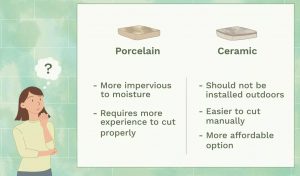 Be very careful when shopping at big box retailers and stores that offer amazing deals and low pricing. Retailers along tile alley/tile row in Anaheim should be avoided. Never purchase tile that is on clearance or on special. I’ve seen far too many folks bamboozled at these types of locations.
Be very careful when shopping at big box retailers and stores that offer amazing deals and low pricing. Retailers along tile alley/tile row in Anaheim should be avoided. Never purchase tile that is on clearance or on special. I’ve seen far too many folks bamboozled at these types of locations.
VERY IMPORTANT: No regulations require tile products be labeled as “porcelain” based on any specific characteristics. However, the PTCA and American Society for Testing and Materials (ASTM) has a certification process that is voluntary. With that, the retailers have the freedom of describing the tiles they offer any way they like. As for buyers, this makes it a little difficult to decide which tile to purchase and the characteristics it has. Hire a Contractor (like DAD’s Construction – Best Local Contractor!) who knows tile to help you make smart choices. Purchasing defective, incorrect, or mislabeled tile guarantees poor results for your bathtub project.
This next part is really important. So, please follow along carefully. The porcelain tile itself is part one of a six-part installation equation. When installing tile around the bathtub, you must pay attention to:
Substrate
- Cement floor:
 The cement floor must be free of potholes. It must be clean of all debris, adhesives, mold, mildew, grout, and moisture.
The cement floor must be free of potholes. It must be clean of all debris, adhesives, mold, mildew, grout, and moisture.- The drain and its size must be correct for your type of bathtub. Never reuse the drain and overflow assembly. Always replace these items. Never reuse the existing parts. Check the p-trap. The p-trap assembly is almost always cracked or broken. Now is the time to replace!
- Prior to the year 2000, many tub drains were not cemented around. They were installed in open dirt. This allowed leaking tub drains and overflows to “drain” into the open dirt under your tub. Tub drains are design much better today. They should not leak once installed! This created a nasty, albeit hidden, environment for mold, mildew, insects, and bacteria to flourish. Current building codes do not allow open dirt around tub drains. This is very unhealthful. If the tub drain under your tub is open, remove the dirt, disinfect, recompact, add a liner, and pour cement around the liner.
- Wood Floor:
 Is the wood floor solid (no squeaks or bounce)? Repair or replace all loose and damaged boards.
Is the wood floor solid (no squeaks or bounce)? Repair or replace all loose and damaged boards.- Check for water damage. Do not leave any rotten or damaged structural lumber or floor sheeting. Replace all damaged wood.
- Is the wood floor clean of all debris, adhesives, mold, mildew, grout, and moisture?
- The drain and its size must be correct for your type of bathtub. Never reuse the drain and overflow assembly. Never reuse the existing parts. Here too, inspect the p-trap. I rarely find cracked or broken p-traps in wood floors.
Underlayment
All bathtub’s must be set in a forming base. There are a few exceptions to this – but not many. Some bases are solid. Others come with the tub. Most require the installer to mix and pour in place. This is how the tub is properly leveled. If you had a tub replaced and you are trying to figure out why:
 Tub does not drain completely.
Tub does not drain completely.- Tub is not level.
- Tile is not level and straight across the bottom, top, and/or corners.
- The tub enclosure is crooked, and the door alignment is off.
- Tub overflow is not properly aligned and/or leaks.
- It rocks and feels unsteady while inside.
- You can hear grinding sounds under the tub when using.
If a bathtub is installed wrong, there are no easy fixes. Almost without exception, you’ll need to tear the whole bathtub out and start over to fix the problem!
Tub Surround Foundation
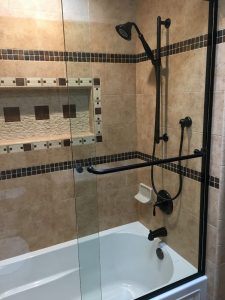 Do not use drywall, cement backer board, Polyethylene sheeting, or Polystyrene Foam Panels. The walls must be properly floated with cement. This is similar to the stucco on the outside of your house. However, the cement mixture for a bathtub is a special custom blend of premium plaster sand, Portland cement, and lime.
Do not use drywall, cement backer board, Polyethylene sheeting, or Polystyrene Foam Panels. The walls must be properly floated with cement. This is similar to the stucco on the outside of your house. However, the cement mixture for a bathtub is a special custom blend of premium plaster sand, Portland cement, and lime.
Failure to use cement will likely result in your bathtub and/or walls leaking, uneven tile installation, crooked walls, and an improperly installed bathtub enclosure. For more information on remodeling a bathtub, see the articles Bath Remodel and Remodeling a Bathtub by DAD’s Construction.
Tile
If the box does not say porcelain tile (make sure it arrives direct from the supply house boxed), don’t accept it.
Grout
If the tile is porcelain but the grout is not high early strength, ANSI certified and exceeds A118.6 or A118.7 standards, you’re wasting your money. Why? The porcelain tile may be waterproof, but your grout will not be!
The Installation Processes
Tile installation requires professional experience. Do it wrong and you can easily experience cracking tile, loose tiles, grout coming out, and pooling of water behind the walls. This all results in costly water damage to your house (interior and exterior). Common problems associated with incorrectly installed bathtubs are water damage and serious mold, insect, and toxic airborne pathogens that can make you and your family very ill. Installing a bathtub tile surround incorrectly can be very dangerous for both you and your house. However, if performed right, there is simply no better, stronger, or more durable system for your bathtub.
The next time you are wondering “Is Porcelain or Ceramic Tile Better for Bathtubs?”, now you know!
Always Hire a Reliable and Dependable Contractor to Remodel your Bathroom
 Always work with a trustworthy contractor like DAD’s Construction. We are experts in bathroom remodeling who can manage projects in an efficient manner. DAD’s Construction will do everything to minimize the possibility of change orders. Our team will make sure we have all the necessary information to prepare a proposal that meets your requirements. Rest assured that we will provide you with a detailed, by line-item contract. We will make sure that the contents of this agreement are properly and clearly communicated to you. If you have questions or need updates regarding your project, we will always answer your inquiries.
Always work with a trustworthy contractor like DAD’s Construction. We are experts in bathroom remodeling who can manage projects in an efficient manner. DAD’s Construction will do everything to minimize the possibility of change orders. Our team will make sure we have all the necessary information to prepare a proposal that meets your requirements. Rest assured that we will provide you with a detailed, by line-item contract. We will make sure that the contents of this agreement are properly and clearly communicated to you. If you have questions or need updates regarding your project, we will always answer your inquiries.
How Can I Receive More Information on Remodeling my Bathroom?
If you would like more information on enjoying the best bathroom, kitchen, and interior remodeling experience in Orange County, call Dan at (949) 380-0177 or at dan@dadsconstruction.com for a free in home consultation. DAD’s serves all of South Orange County California. This includes Lake Forest, Mission Viejo, Foothill Ranch, Portola Hills, Ladera Ranch, Irvine, San Clemente, Dana Point, San Juan Capistrano, Rancho Santa Margarita, Coto de Caza, Dove Canyon, Laguna Niguel, Laguna Hills, Laguna Beach, Newport Beach, and Aliso Viejo.
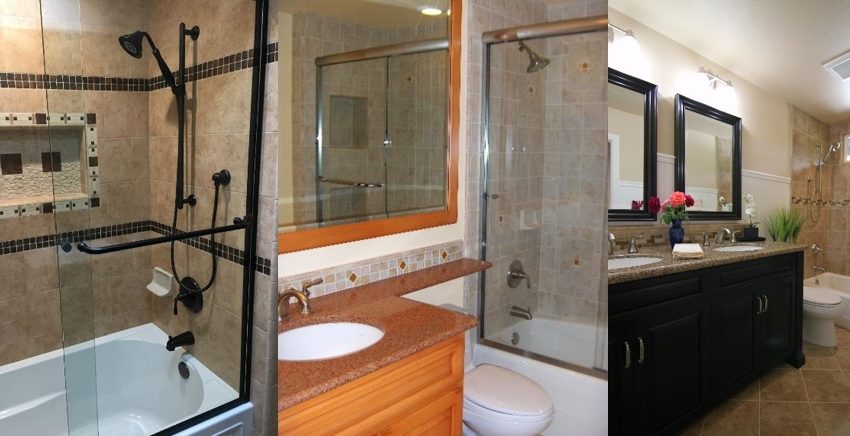
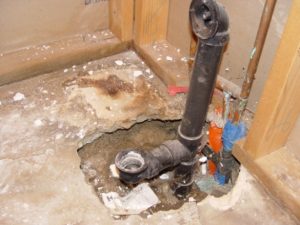 The cement floor must be free of potholes. It must be clean of all debris, adhesives, mold, mildew, grout, and moisture.
The cement floor must be free of potholes. It must be clean of all debris, adhesives, mold, mildew, grout, and moisture.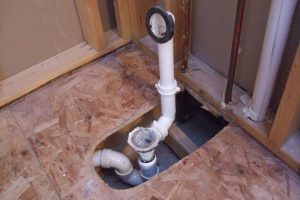 Is the wood floor solid (no squeaks or bounce)? Repair or replace all loose and damaged boards.
Is the wood floor solid (no squeaks or bounce)? Repair or replace all loose and damaged boards.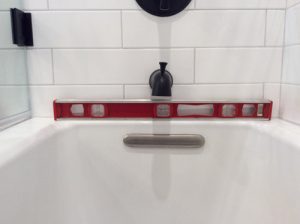 Tub does not drain completely.
Tub does not drain completely.